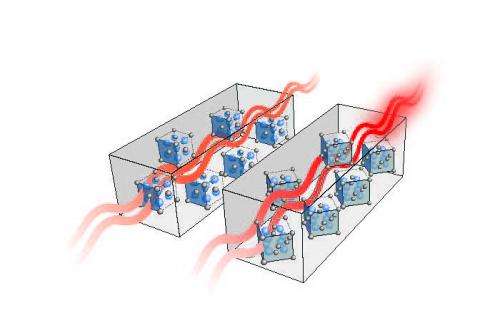Reactor fuel behavior better understood with phonon insights

(Phys.org) —Nearly 20 percent of the electricity in the United States is generated by nuclear energy from uranium dioxide fuel, but mysteries still surround exactly how the material controls the electrical production: Poor thermal conductivity can limit the conversion rate of heat produced by fission, however we don't know the physics underlying this behavior or, as it turns out, some of the properties to which it gives rise.
"A deeper understanding of the physics that governs the performance of important engineering materials, such as uranium dioxide, should lead to improvements in efficiency and safety," said David Andersson, a Los Alamos National Laboratory scientist on the project, "which are ultimate goals of the Department of Energy's program to develop advanced predictive computer models of nuclear reactor performance."
New research at Los Alamos is showing that the thermal conductivity of cubic uranium dioxide is strongly affected by interactions between phonons carrying heat and magnetic spins. "This leads to unexpected behavior of the thermal conductivity: For example, in single crystals the measured thermal conductivity is different along the side or edge of the cubic unit cell than along the diagonal, even at and above room temperature," said Andersson.
A solid is said to be isotropic if the properties are equal in all directions: UO2 has always been assumed to be isotropic, Andersson said, but "after our discovery of anisotropic thermal conductivity we realized that there were hints of this behavior as the material wasn't always behaving as expected."
This matters for the nuclear power industry because some of the uncertainty in historical experimental data may have been due to hidden anisotropy rather than measurement uncertainties or sample impurities.
"UO2 has always been assumed to be isotropic due to its cubic crystal structure. In contrast to this, the measured thermal conductivity anisotropy shows us that UO2 really does not behave like we would expect for a simple cubic material", Andersson noted. This result is surprising because there is no clear evidence of non-cubic distortions for either the paramagnetic or the antiferromagnetic phases of UO2 in diffraction experiments.
The anisotropy is explained by the phonon-spin scattering mechanism coupling to the applied temperature gradient and thus breaking cubic symmetry. "This insight made us realize that the same phonon-spin scattering is responsible for the poor UO2 thermal conductivity in general, which is one of the most important and limiting factors in determining nuclear fuel performance and safety."
The paper was published today in Nature Communications.
History at Los Alamos
Los Alamos has been a leader in nuclear-related research since its founding in 1943, and the nuclear power expertise at the facility has been recognized worldwide for many years. Los Alamos scientists have focused on reactor fuel such as uranium and plutonium since the Manhattan Project days, and the research by these teams has aided nuclear power safety worldwide.
Over the last several decades, the International Atomic Energy Agency has relied on Los Alamos for the development of instruments and software to track nuclear fuel at every stage of its development, use and storage. Such research has helped prevent the diversion of nuclear materials into the hands of terrorists and other non-state actors.
The depleted uranium dioxide crystals used for the thermal conductivity measurements were obtained in 1969 by Los Alamos Scientific Laboratory (now Los Alamos National Laboratory) from Pacific Northwest Laboratory (now Pacific Northwest National Laboratory).
More information: "Anisotropic thermal conductivity in uranium dioxide." K. Gofryk, et al. Nature Communications 5, Article number: 4551 DOI: 10.1038/ncomms5551. Received 09 May 2014 Accepted 27 June 2014 Published 01 August 2014
Journal information: Nature Communications
Provided by Los Alamos National Laboratory



















